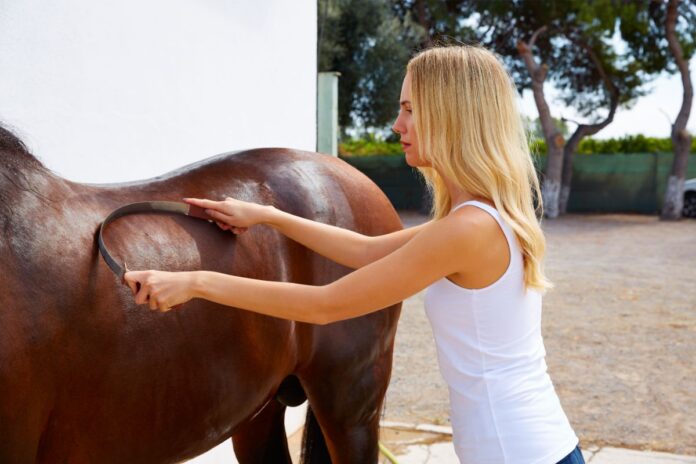ELECTROLYTE LOSSES AND REQUIREMENTS
By Kate Hore, RNutr(Animal), R.Anim.Technol(Cert). head nutritionist at NAF
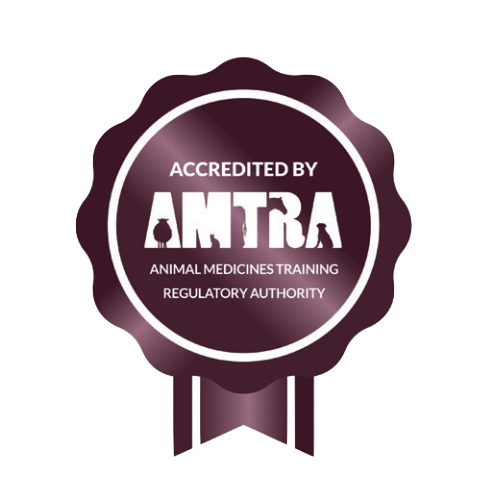
AMTRA is required by the Veterinary Medicines Regulations to ensure its RAMAs/SQPs undertake CPD. All RAMAs/SQPs must earn a certain number of CPD points in a given period of time in order to retain their qualification. RAMAs/SQPs who read this feature and submit correct answers to the questions below will receive two CPD points. For more about AMTRA and becoming a RAMA/SQP, visit www.amtra.org.uk
‘Horses sweat, men perspire...’ so the saying goes, but do we know the importance of sweat? Sweat losses are a critical aspect of equine competition nutrition. Often thought of as only for elite performers, replacing sweat losses is vital for all.
SWEAT
Sweat is a clear, salty solution that horses – like us – use to help regulate body temperature, particularly when exercising, through evaporation from the skin.
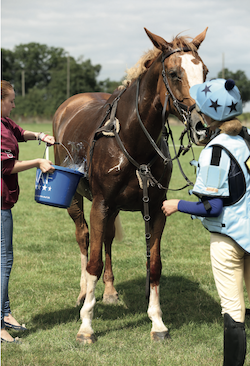
Horses have a high sweat rate, and use sweating as the primary, and most effective, method of thermoregulation. Sweat is lost via glands across the body which secrete the fluid via hair follicles, and the horse has around 800 glands per square centimetre!
The action of sweating is controlled by nerve signals from the brain to the skin, and activated by the action of the hormone adrenaline. Sweat consists primarily of water and the body ions, or electrolytes. However, horse sweat also contains proteins including latherin, which causes the white foam we see on heavily sweating horses.
Horses have particularly concentrated sweat, it being described as hypertonic to plasma, meaning it contains more electrolytes and is at greater osmotic pressure than body fluid, or plasma, would be. This is particularly true in heavily sweating horses, as the higher the level of sweat, the more concentrated it becomes, until proportionally more salt is lost than water.
ELECTROLYTES
Electrolytes are electrically charged body salts, or ions, responsible for many key functions within the body. They are crucial to the balance of the acid-base status in the body, which ensures the right ratio of acidic to basic (alkaline) compounds in solution is maintained.
This equilibrium is vital for the body to function normally. The most important to the horse are Sodium (Na+), Potassium (K+) and Chloride (Cl-); though Magnesium (Mg2+) and Calcium (Ca2+) also have cation (positively charged) roles to play.
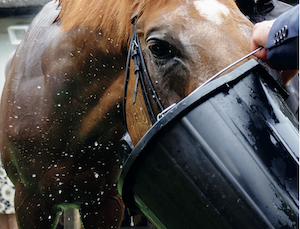
Sodium and Chloride are typically provided together, being the salt we are all familiar with (NaCl), and over half of the body’s sodium is in the bones. Potassium is mainly concentrated in the muscles, while the chloride is more evenly distributed through the body.
Once sweating starts, large amounts of electrolytes can be lost in a relatively short amount of time. Many factors will influence how much sweat is lost including temperature, humidity and exercise rate. Rates of up to 20 litres of fluid lost from endurance horses in hot weather racing are recorded, which relates to around 4-6% of total body weight.
Loss of electrolytes and water in sweat has a measurable effect on that vital acid-base balance discussed, with prolonged moderate intensity exercise typically causing mild alkalosis through chloride loss.
Early signs of dehydration include a drop in performance and concentration, whilst long-term can lead to fatigue, weakness and has been associated with issues such as thumps (Diaphragmatic flutter) and tying-up (Exertional rhabdomyolysis).
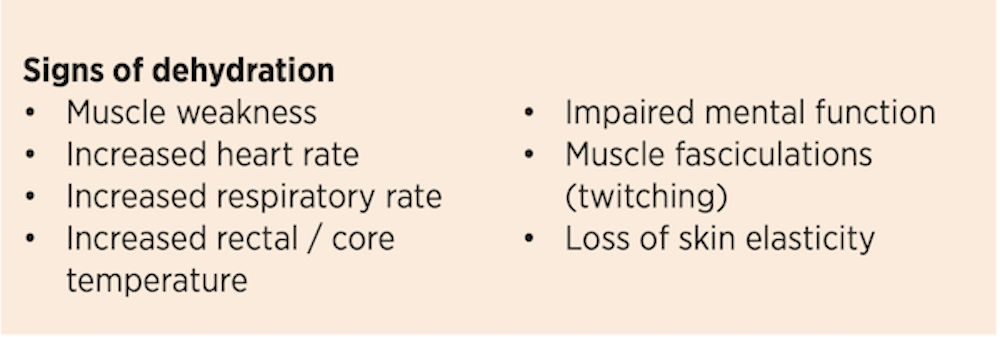
HOW AND WHEN TO FEED
Sweat losses need to be replaced whenever the horse has sweated, generally when they are working above a very light work regime. Horses are very good at dissipating sweat, and it is easy for sweat losses to go relatively unnoticed, as the horse will certainly not always be ‘dripping’. So what do we advise our customers to look for?
There are several different ways of trying to calculate sweat losses, but nearly all have their own limitations and are not necessarily practical for the horse owner.
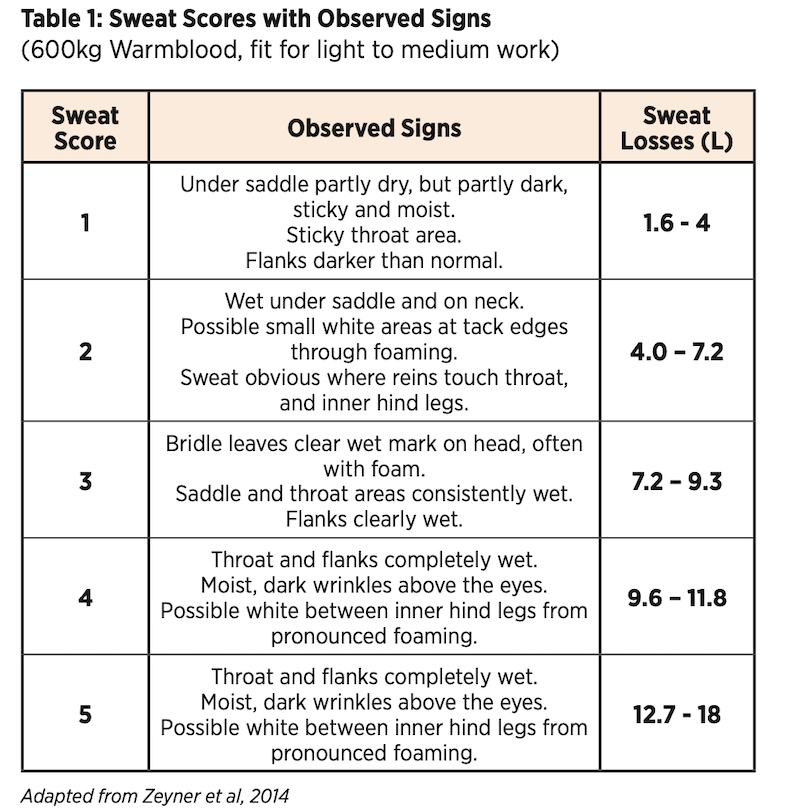
Research in Germany has aimed to design a ‘Sweat Score’ with easily recognisable signs that owners can relate to. That work also used body weight loss to establish actual losses, so we can see that even a slightly damp saddle cloth relates to sweat losses of up to 4L in a typical Warmblood (Table 1).
Advising owners to simply feel the saddle cloth, or the skin under the saddle, to check for damp areas is a good way of raising awareness of the need to supplement electrolytes, whether training, hacking or competing. Once we’ve decided we need to supplement, what is the best way to do it?
It is important to remember that as well as the electrolytes themselves, the sweat losses include significant amounts of water. It is imperative that water is replaced alongside the electrolytes, as failure to do so will cause the high osmolality (solution concentration) in the stomach and gut to draw water from the blood, across the gut wall, so actually further dehydrating the horse.
JUST BECAUSE YOU FEED ELECTROLYTES, DOES NOT MEAN THEY GET INTO THE HORSE.
Further, use of super-concentrated electrolytes, such as pastes, can act as an irritant in the stomach and have been found to cause gastric ulcers (Holbrook et al 2005). Recently it was reported that this risk is becoming known by rider populations, meaning horses are missing out on vital electrolytes through rider concerns (Alshut et al 2022).
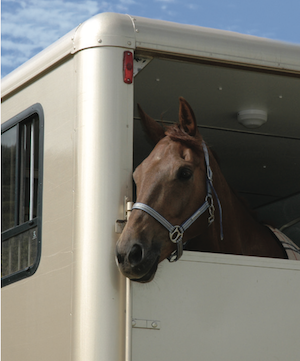
Therefore we have a responsibility to promote essential, and safe, feeding of these required salts. The best way to do that is to add electrolytes to a really wet feed – something like well soaked sugar beet – or to acclimatise the horse to taking electrolytes from drinking water. A wet, fibrous feed is ideal, as the fibre also helps support the gut’s role as a fluid reservoir for hydration. Either way, ensure clean, fresh water is also always available.
Electrolytes should be given whenever the horse has worked hard, and when observed signs show that sweating has taken place (Table 1). Not just for competing horses, remember mares during foaling and stallions during covering will both also require electrolytes. Lastly, as travel always results in sweating, if the horse has travelled, then electrolytes are recommended.
Research shows pre-loading is advised, i.e. feeding electrolytes one hour before travelling. This should be sufficient to see them through the competition. However, if that journey is more than two hours long, rest breaks should be provided and electrolytes fed (Lindinger 2022, Waller & Lindiger 2023). Post-competition electrolyte supplementation is also important to aid recovery.
CONCLUSION
As equine health advisors, it is our responsibility to know the importance of electrolytes to working horses, and how to advise their safe and appropriate use to horse owners.
Selected References
- Alshut F, Martinsson G, Venner M & Vervuert I (2022) Salt supplementation in exercising horses: any harmful effects on gastric mucosa? Proceedings of EWEN, Equine Nutrition to Industry Event. Cirencester Aug 22.
- Holbrook T.C, Simmons R.D, Payton M.E & MacAllister C.G (2005) Effect of repeated oral administration of hypertonic electrolyte solution on equine gastric mucosa. Equine Vet Jn. 37, 501- 504
- Lindinger M.I (2022) Oral electrolyte and water supplementation in horses. Vet Sci. 9, 626
- Waller A.P & Lindiger M.I (2023) Tracing acid-base variables in exercising horses: effects of pre- loading oral electrolytes. Animals. 13, 73
- Zeyner A, Romanowski K, Vernunft A, Harris P & Kienzle E (2014) Scoring of sweat losses in exercised horses – a pilot study. J. Anim Physiol Anim Nutr (Berl). Apr 98(2) 246-50

ABOUT ETN’S RAMA/SQP FEATURES
ETN’s series of CPD features helps RAMAs (Registered Animal Medicines Advisors/SQPs) earn the CPD (continuing professional development) points they need. The features are accredited by AMTRA, and highlight some of the most important subject areas for RAMAs/ SQPs specialising in equine and companion animal medicine.
AMTRA is required by the Veterinary Medicines Regulations to ensure its RAMAs/SQPs undertake CPD. All RAMAs/SQPs must earn a certain number of CPD points in a given period of time in order to retain their qualification. RAMAs/SQPs who read this feature and submit correct answers to the questions below will receive two CPD points. For more about AMTRA and becoming a RAMA/SQP, visit www.amtra.org.uk










